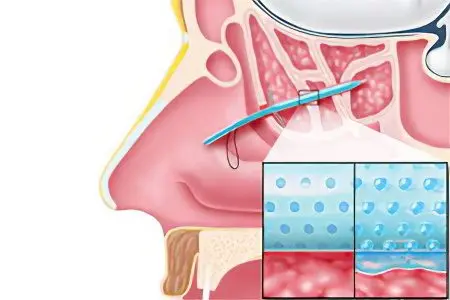Contents
YAMIK catheter
The non-puncture Yamik method has recently received wide application in the treatment of sinusitis. This ENT procedure was invented by the doctor V.S. Kozlov. The meaning of the procedure is that it allows you to treat sinusitis without a puncture.
Conservative treatment of sinusitis involves puncturing the sinuses and washing them with antibiotics and mucus thinners – this procedure is painful, the recovery process is long, but, as a rule, even in the past, this method was resorted to in extreme, advanced cases. Therefore, the emergence of a way to treat sinusitis without a puncture has become a real breakthrough in medicine.

Yamik method – the principle of the procedure is to “suck out” the contents from the paranasal sinuses. In this case, the process is considered natural, because surgical intervention does not occur. The walls of the sinuses are not injured, as the pit catheter is made of soft latex. In addition to the treatment of sinusitis, this method is used for frontal sinusitis. Yamik catheters come in several varieties. Their main difference is in the diameter of the channels. After all, it is impossible to perform the procedure on a child with the same catheter as on an adult.
Yamik catheter device
The YAMIK catheter is a small system that consists of a body and a cuff. The body consists of:
Cylinder rear
balloon inflation valve
metal rod
The cuff consists of:
front cylinder
balloon inflation valve
Channel working
Syringe adapter
The procedure is carried out in several stages, but lasts only no more than 8 minutes. They do it on an outpatient basis, without special complex preparation of the patient. The Yamik method is well tolerated even by children.
Preparing for the procedure
During the procedure with a Yamik catheter, the patient is seated. The doctor performs anesthesia on one or both (with bilateral sinusitis) sides of the nose. In this case, the internal, nasal mucosa is also subjected to anesthesia. After the medicine has worked, the sinus catheter is adjusted to the structure of the nasal cavity of a particular patient. This is easy to do, since the catheter has a plastic rod that can be bent. Then, under the close supervision of a physician, the Yamik catheter is inserted into the nasal cavity. It is more convenient to do this along the lower part of the nasal canal. When the posterior balloon is in the nasopharynx, it is inflated by introducing air into it. Do this with a syringe. This completes the preparation for the procedure.
Procedure
Before starting the procedure, the nasal cavity is treated with special vasoconstrictor agents. Then, a latex sinus catheter is inserted into the nasal cavity from one side. After the balloons are introduced, one of them begins to gradually inflate inside the nasopharynx, and the second in the nostril. The patient tilts his head at a certain angle. With a small syringe, the contents of the maxillary sinuses are sucked out – pus, mucus. This is the first stage of the procedure.
Then, the drug solution contained in it is injected with another syringe. The patient tilts his head now in the opposite direction and as a result of this, the solution is pumped into the liberated sinuses. This completes the procedure and the sinus catheter can be removed from the nose. But if the patient suffers from bilateral sinusitis, then it is necessary to repeat the entire procedure, but now on the other side.
Advantages
The most important advantage of the procedure for treating sinusitis with a Yamik catheter is its painlessness. The absence of punctures and damage to the sinuses and the inside of the nose allows the patient to recover immediately after the procedure. The therapeutic effect during the procedure is multilateral, it affects all the paranasal sinuses at once.
Therefore, it is possible to treat this way not only sinusitis, but also frontal sinusitis, polysinusitis, sphenoiditis, ethmoiditis. Due to the fact that this method is gentle, it is used to treat pregnant women and young children. Almost all patients tolerate the procedure calmly and for the entire time of the existence of this method, there have been only positive reviews from patients after treatment. In addition, doctors also recognize the Yamik method as the best at the moment, excluding advanced forms of sinusitis.
Yamik catheter and treatment of children
The Yamik catheter procedure for the treatment of sinusitis and other nasal diseases in children is almost the same as in adults. For the procedure, a catheter with a small diameter of channels and balloons is used. However, unlike adult patients, the child must be mentally prepared. After all, the child may react negatively to the doctor’s attempts to insert a catheter into his nose. Parents must explain to the child in advance the whole meaning of the procedure at a level accessible to the child. The task of the doctor is to turn the procedure into a game, distracting the child from feelings of fear and discomfort. Catheterization of the sinuses of a child’s nose is actively used in modern otolaryngology. In this case, all the anatomical features of the structure of the nasal sinuses of the child are strictly taken into account. Only in this way the procedure will not leave bad memories in the child.
To obtain a lasting effect and fix the result of treatment of sinusitis with a Yamik catheter, it is necessary to carry out at least 2 procedures, and it is desirable that there be 8 of them. Most often, 3-4 sessions are prescribed, which is enough to achieve the desired result.
Indications and contraindications

The indications for the procedure with a Yamik catheter are as follows:
Sinusitis
Frontitis acute
polysinusitis
ethmoiditis
sphenoiditis
preparation for major surgery
the occurrence of purulent sinusitis after surgical operations
The procedure is contraindicated in such cases:
hemorrhagic vasculitis
polyposis of the inner lining of the nose of a total nature
old age
Thanks to the emergence in otolaryngology of the ability to treat sinusitis without surgery, the treatment of the disease and recovery after it began to take much less time. In terms of efficiency, the procedures performed with the YAMIK catheter are superior to conservative methods of treatment.
Balloon sinusoplasty

Balloon sinusoplasty is a surgical procedure for the treatment of sinusitis (chronic and acute). However, this method is not traumatic and belongs to minimally invasive surgical procedures. Its essence is reduced to the expansion of the anastomosis of the sinuses using a special balloon catheter. The sphenoid, maxillary and frontal sinuses may be affected, depending on the condition of the patient. The intervention requires endoscopic equipment.
Balloon sinusoplasty procedure
The procedure is carried out in stages:
A system for sinusoplasty is inserted into the inflamed nasal sinus. This is done using a thin guide catheter.
The contents of the nasal sinuses are aspirated by probing, for this a conductor connected to the light is used. Using a light source allows the clinician to clearly visualize the location of the guidewire tip.
A balloon catheter is inserted through the guide into the anastomosis.
A liquid is injected into the balloon, due to which it swells. The exposure time does not exceed 5 seconds, then it is blown off. At the same time, the anastomosis increases in the lumen, which makes it possible to wash the sinus using therapeutic solutions. Accumulated pus and mucus are flushed out of the affected sinuses.
All equipment is removed from the nose.
After the procedure is completed, the sinuses remain open, allowing them to function normally. It is worth knowing that only a doctor who has a certificate and skills in endoscopic surgery has the right to perform this kind of intervention.
It is also important that the implementation of minimally invasive surgery on the sinuses is not an obstacle to the implementation of other methods of treating sinusitis. It may well be combined with other therapeutic procedures, the decision on the need for which will be made by the doctor.
Watch a visual video of what balloon sinusoplasty is:










გამარჯობათ სად შეიძლება ამ პროცედურის გაკეთება რომელ კლინიკაში